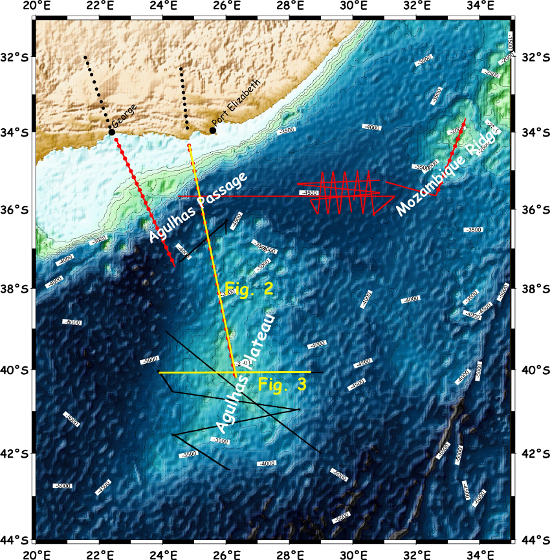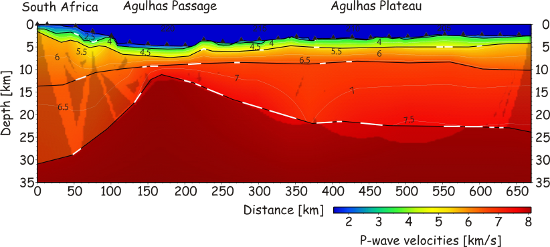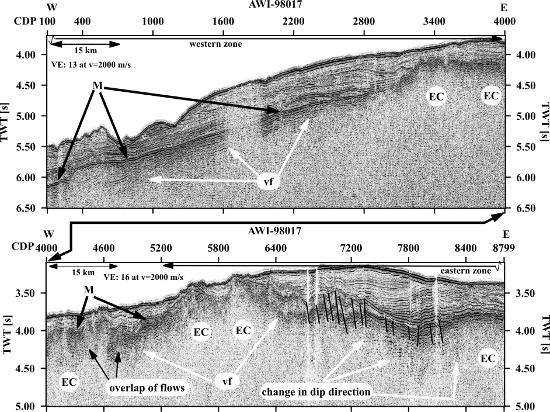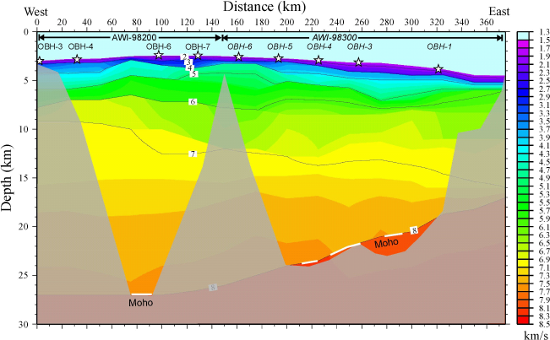September 2007 LIP of the Month
September 2007 LIP of the Month
The Agulhas Plateau – a Large Igneous Province in the SW Indian Ocean
Gabriele Uenzelmann-Neben, Karsten Gohl, Nicole Parsiegla
Alfred-Wegener-Institut für Polar- und Meeresforschung, P.O. Box 12 01 61, 27515 Bremerhaven, Germany
Gabriele.Uenzelmann-neben@awi.de
The Agulhas Plateau is an oceanic plateau south of South Africa in the southwestern Indian Ocean (Fig. 1). It rises up to 2500 m above the surrounding seafloor, covers an area of more than 300,000 km2 and hence represents a major bathymetric high in this region. The Agulhas Plateau is separated from the South African continent by the up to 4700 m deep Agulhas Passage. While the northern Agulhas Plateau is characterised by a very rugged topography and basement morphology, the southern part of the plateau shows a much smoother topography and basement morphology (Allen and Tucholke, 1981; Tucholke et al., 1981; Parsiegla et al., submitted).

Figure 1: Bathymetric map of the area south of South Africa showing the seismic reflection and refraction lines acquired on the Agulhas Plateau (Uenzelmann-Neben et al., 1999; Gohl and Uenzelmann-Neben, 2001; Parsiegla et al., submitted). Bathymetry according to Sandwell and Smith (1997).
Although a continental origin has been suggested for the southern Agulhas Plateau (Allen and Tucholke, 1981; Tucholke et al., 1981; Angevine and Turcotte, 1983), recent seismic reflection and refraction surveys revealed the Agulhas Plateau to be a Large Igneous Province LIP (Uenzelmann-Neben et al., 1999; Gohl and Uenzelmann-Neben, 2001; Parsiegla et al., submitted). Lava flow structures, crustal thicknesses of up to 25 km and high velocities of 7.0-7.6 km/s for the lower part of the crust as well as the observation of an extrusive cover, an intruded middle part and a lower crustal body (Uenzelmann-Neben et al., 1999; Gohl and Uenzelmann-Neben; Parsiegla et al., submitted) let the Agulhas Plateau fall within the world wide suite of LIPs (e.g. Coffin and Eldholm, 1994). The total volume of the Agulhas Plateau was estimated to be 4 * 106 km3. It has been further suggested that the Agulhas Plateau was formed as part of a larger LIP comprising the Agulhas Plateau, the Northeast Georgia Rise and the Maud Rise (Uenzelmann-Neben et al., 1999; Gohl and Uenzelmann-Neben, 2001; Parsiegla et al., submitted). With a suggested time of formation of 100-95 Ma this LIP will have had a major impact on both path and intensity of oceanic currents and hence the climate during the Late Cretaceous.

Figure 2: Velocity-depth model extending from the South African continent to the Agulhas Plateau (Parsiegla et al., submitted).


Figure 3: a) Seismic reflection profile across the central Agulhas Plateau showing volcanic flows (vf). EC= extrusion centre, M= Maastrichtian.
b) Velocity-depth model across the central Agulhas Plateau. Modified from Gohl and Uenzelmann-Neben (2001).
References
Allen, R.B.; Tucholke, B.E. (1981), Petrography and implications of continental rocks from the Agulhas Plateau, southwest Indian Ocean. Geology, 9, 463-468.
Angevine, C.L.; Turcotte, D.L. (1983), Correlation of Geoid and and Depth Anomalies over the Agulhas Plateau. Tectonophysics. 100, 43-52
Coffin, M.F.; Endholm, O. (1994), Large igneous provinces: crustal structure, dimensions, and external consequences. Reviews of Geophysics. 32, 1-36.
Gohl, K.; Uenzelmann-Neben, G. (2001). The crustal role of the Agulhas Plateau, southwest Indian Ocean: evidence from seismic profiling. Geophys. J. Int., 144, 632-646.
Parsiegla, N.; Gohl, K.; Uenzelmann-Neben, G. (submitted), The Agulhas Plateau: Structure and evolution of a Large Igneous Province and its impact on the Cretaceous environment. Geophys. J. Int.
Sandwell, D.T.; Smith, W.H.F. (1997), Marine gravity anomaly from Geosat and ERS 1 satellite altimetry. J. Geophys. Res. 102, 10039-100054.
Tucholke, B.E., Houtz, R.E., Barrett, D.M. (1981). Continental crust beneath the Agulhas Plateau, southwest Indian Ocean. Journal of Geophysical Research, 86, 3791-38061.
Uenzelmann-Neben, G., Gohl, K., Ehrhardt, A., Seargent, M. (1999). Agulhas Plateau, SW Indian Ocean: New evidence for excessive volcanism, Geophys. Res. Lett, 26/13, 1941-1944.